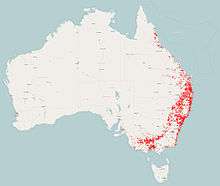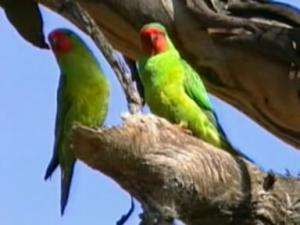Little lorikeet
| Little lorikeet | |
|---|---|
| | |
| Scientific classification | |
| Kingdom: | Animalia |
| Phylum: | Chordata |
| Class: | Aves |
| Order: | Psittaciformes |
| Superfamily: | Psittacoidea |
| Family: | Psittaculidae |
| Subfamily: | Loriinae |
| Tribe: | Loriini |
| Genus: | Glossopsitta |
| Species: | G. pusilla |
| Binomial name | |
| Glossopsitta pusilla (Shaw, 1790) | |
 | |
| The Distribution of the little lorikeet, Data from The Atlas of Living Australia | |
The little lorikeet (Glossopsitta pusilla) is a species of parrot in the family Psittaculidae. It is endemic to Australia. It is a small parrot, predominantly green in plumage with a red face. Its natural habitats are subtropical or tropical dry forests and subtropical or tropical moist lowland forests.
Taxonomy
The little lorikeet was first described by ornithologist George Shaw in 1790 as Psittacus pusillus. Its specific epithet is the Latin pusilla "small".[2] Other common names include tiny lorikeet, red-faced lorikeet,[3] gizzie, slit,[4] and formerly a local indigenous term gerryang.[5]
Description
Measuring 15 cm (5.9 in) in length, the male and female are similarly coloured, although the latter is a little duller. The crown, lores and throat are red, the nape and shoulder bronze-coloured and the remainder of the plumage green. The underparts yellow-tinged. The bill is black and the iris golden in colour.[3]
Distribution and habitat
The little lorikeet is found in eastern and southern Australia, from the vicinity of Cairns southwards through Queensland and New South Wales from the western slopes of the Great Dividing Range eastwards to the coast, though most of Victoria and southeastern South Australia. It also occurs in Tasmania although is uncommon there.[6] They are found in forest, especially in the vicinity of flowering or fruit-bearing vegetation.[7]
Feeding
Fruit and flowers form the bulk of their diet, including native grasstrees (Xanthorrhoea spp.), and tea-tree (Melaleuca spp.), Loranthus, and the introduced loquat (Eriobotrya japonica). They will occasionally visit orchards.[7]
Breeding
Breeding season is from May in the north, or August in the south, to December. The nest is a hollow in a tree and a clutch of 3-5 matte white roundish eggs, measuring 20 x 16 mm, is laid. The incubation period is around three weeks.[7]
Aviculture
Although first exported to Europe in 1877, the little lorikeet is only very rarely seen outside Australia. Even in its native country, it is uncommon in captivity.[8] It has a reputation of being difficult to keep.[9]

References
- ↑ BirdLife International (2012). "Glossopsitta pusilla". IUCN Red List of Threatened Species. Version 2013.2. International Union for Conservation of Nature. Retrieved 26 November 2013.
- ↑ Simpson DP (1979). Cassell's Latin Dictionary (5th ed.). London: Cassell Ltd. p. 883. ISBN 0-304-52257-0.
- 1 2 Low, p. 119
- ↑ Lendon, p. 31
- ↑ Long, George (1841). The Penny Cyclopædia of the Society for the Diffusion of Useful Knowledge. London: Charles Knight & Co. p. 90.
- ↑ Lendon, p. 31-32
- 1 2 3 Forshaw, Joseph M. & Cooper, William T. (1978). Parrots of the World (2nd ed.). Melbourne: Landsdowne Editions. p. 90. ISBN 0-7018-0690-7.
- ↑ Low, p. 120-21
- ↑ Lendon, p. 33
Cited texts
- Lendon, Alan H. (1973). Australian Parrots in Field and Aviary (2nd ed.). Sydney: Angus and Robertson. ISBN 0-207-12424-8.
- Low, Rosemary (1978). Lories and Lorikeets. Melbourne: Inkata Press. ISBN 0-909605-08-4.
| Wikimedia Commons has media related to Glossopsitta pusilla. |
| Wikispecies has information related to: Glossopsitta pusilla |
